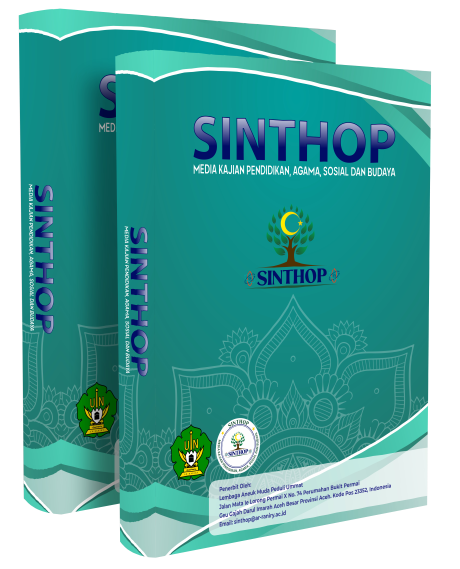Deciphering the Concept of Goodness in Islam: A Comprehensive Qur’anic Linguistic and Thematic Analysis
DOI:
https://doi.org/10.22373/sinthop.v3i1.5553Keywords:
Al-khair, Goodness, Quran, TafsirAbstract
This article delves into the concept of “goodness” (al-khair) within Islamic teachings as interpreted from the Qur’an, exploring its nuanced and context-dependent meanings. Al-khair in Arabic signifies all that is good and beneficial, standing in contrast to al-syar, which represents evil and wrongdoing. This study employs a descriptive-analytical qualitative approach, utilizing a detailed examination of Qur’anic verses, Tafsir literature, and Hadiths to unravel the layered meanings of al-khair. Our findings highlight that al-khair not only encompasses moral and social virtues but also material aspects such as wealth and physical well-being. The term is comparable to thayyibun, husnun, birrun, and ma’ruffun in the Qur’an, each carrying distinct but sometimes overlapping meanings. The analysis distinguishes three key dimensions of al-khair: the ultimate good deeds chosen for humanity, the commendable acts ordained by Allah, and attributes often associated with Allah’s characteristics. The study concludes that while goodness is generally perceived as desirable, its interpretation can vary significantly, leading to both positive and negative outcomes depending on the context.
References
Abd al-Baqi, M. F. (1945). Al-Mu’jam al mufahras li-alfaz al-Qur’an al-karim. Matabi’a;-Sha’b.
Ainiyah, S. M. (2018). Konsep Ihsan dalam Al Qur‟ an dan kontekstualisasinya di Era Imagologi. Doctoral Dissertation, UIN Sunan Ampel Surabaya.
Al-Jazairi, A. B. J., & Bakar, S. A. (2007). Tafsir Al-Qur’an Al-Aisar terj. M. Azhari Harim Dan Abdurrahim Mukti. Jakarta: Darus Sunnah.
al-Qurthubi, S. I. (2008). al-Jȃmi’li Ahkȃm al-Qur’ȃn, Tafsir Al Qurthubi. terj. Ahmad Khotib, Jakarta: Pustaka Azzam.
Arif, Z., Abdurrahman, A., & Zulfitria, Z. (2021). Kosa Kata Kebaikan dalam Al Quran:(Analisis Makna Kata al-Khair, al-Tayyib, dan al-Hasanah). Al-I’jaz: Jurnal Studi Al-Qur’an, Falsafah Dan Keislaman, 3(1), 98–112.
Ath-Thabari, A. J. (2009). Tafsir Ath-Thabari 20.(fathurrozi, & a. taslim, Penerj.) Jakarta: Pustaka Azzam.
Enoh, E. (2007). Konsep Baik (Kebaikan) dan Buruk (Keburukan) dalam Al-Qur’an. MIMBAR: Jurnal Sosial Dan Pembangunan, 23(1), 15–39.
Faris, I., & Ahmad, A. al-H. (1979). Mu’jam maqayis al-lughah. Beirut: Dar Al-Fikr, 4.
Fauziah, M. (2019). Konsep Kebaikan dalam Perspektif Dakwah. Al-Idarah: Jurnal Manajemen Dan Administrasi Islam, 3(1). https://doi.org/10.22373/al-idarah.v3i1.5130
Ibn, K., & al-Dimashqi, K. (1998). Tafsîr al-Qurân al-’Azhîm. Jilid.
Isfahani, R., & Dawudi, S. A. (2011). Mufradat alfaz al-Qur’an. Dar Al-Qalam.
Manzhur, I. (n.d.). Abu al-Fadlal Jamaluddin Muhammad bin Mukram. Lisan Al-’Arab.
Manzur, I., & bin Mukram, J. M. (1993). Lisan Lil Lisan Tahzib Lisan Arabi. Juz.
Nasional, P. B. D. P. (2005). Kamus Besar Bahasa Indonesia Jakarta: Balai Pustaka. Edisi Ketiga.
Shihab, Q. (2005). Tafsir al-Misbah (vol. 6). Lentera Hati.
Zakariya, I., & bin Faris, A. al-H. A. (1994). Mu’jam al-Maqayis fi al-Lughah. Beirut: Dar Al-Fikr, 1415.
Downloads
Published
How to Cite
Issue
Section
License
Copyright (c) 2024 Zainuddin Zainuddin

This work is licensed under a Creative Commons Attribution-ShareAlike 4.0 International License.
Authors who publish in SINTHOP: Media Kajian Agama, Sosial dan Budaya agree to the following terms:
- Authors retain copyright and grant the journal right of first publication with the work simultaneously licensed Attribution-ShareAlike 4.0 International (CC BY-SA 4.0) that allows others to share the work with an acknowledgment of the work's authorship and initial publication in this journal.
- Authors are able to enter into separate, additional contractual arrangements for the non-exclusive distribution of the journal's published version of the work (e.g., post it to an institutional repository or publish it in a book), with an acknowledgment of its initial publication in this journal.
- Authors are permitted and encouraged to post their work online (e.g., in institutional repositories or on their website) prior to and during the submission process, as it can lead to productive exchanges, as well as earlier and greater citation of published work. (See The Effect of Open Acces)









.png)

.png)
.png)
.png)


